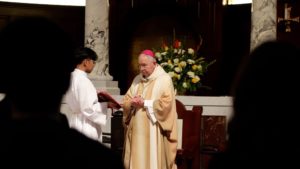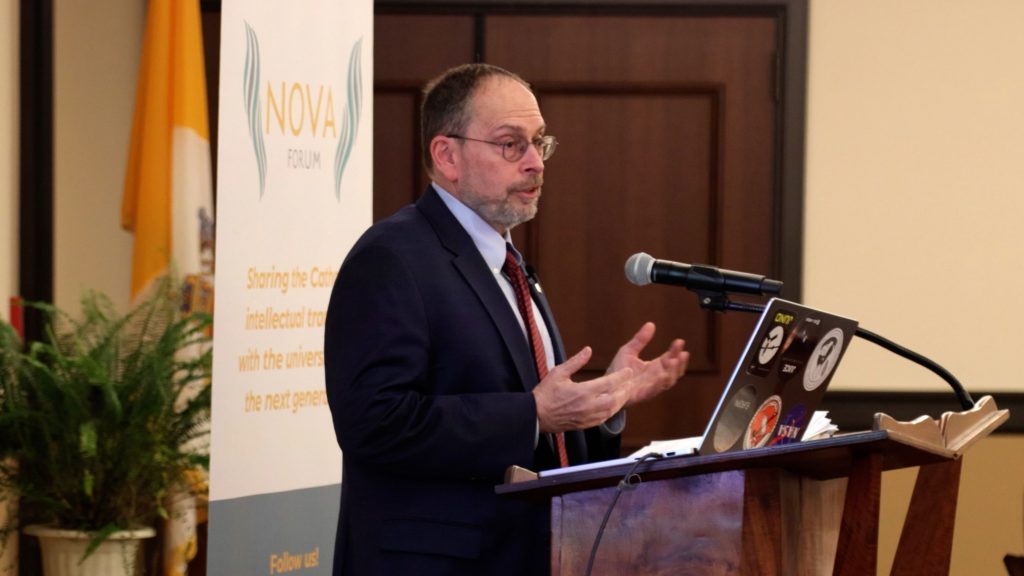In an age when the natural and the divine are so often dismissed as incompatible, what’s a scientist supposed to do with their faith?
The dilemma is nothing new — and nothing to be afraid of — for Jonathan Lunine, Ph.D., the chief scientist at NASA’s Jet Propulsion Lab Chief in Pasadena, a convert to the Catholic faith and co-founder of the Society of Catholic Scientists.
“It takes courage to witness to your faith, especially in situations where the expectation is that the secular point of view is the right point of view,” said Lunine at a Jan. 28 lecture at the University of Southern California Caruso Catholic Center.
Lunine, a self-described “cradle astronomer,” gave the talk after Los Angeles’ first “Gold Mass for Catholics in the Sciences” celebrated by Archbishop José H. Gomez at USC’s Our Savior Church.
The event, held to mark the 800th anniversary of the birth of St. Thomas Aquinas, is part of a broader effort to empower Catholic thinkers working in academic and professional circles increasingly dominated by secularist thought. Two LA-area organizations that are part of that effort, the Nova Forum for Intellectual Thought and the Southern California chapter of the Society of Catholic Scientists, partnered to sponsor the Gold Mass.
In Lunine’s talk, the lifelong astronomer recounted his journey from Judaism to Methodism in his younger years, before his conversion to Catholicism after encounters with the Jesuit fathers and brothers working in the Vatican Observatory group.
“Gradually, my stubborn heart was moved,” Lunine said. “I just suddenly realized that it was time to stop running from the one who had comforted me 33 years earlier.”
Lunine’s remarks focused on the need to inspire young people to embrace their faith alongside their scientific achievements, with various examples of Catholic scientists who did so throughout history. He also argued that, given the varied perceptions of the link between science and faith, the field needed to recognize the limitations of what science can reveal.
“However close science might seem to get to Thomistic philosophy, or however far it might get, science can never be used to prove or disprove the existence of God,” Dr. Lunine said.
At the Mass, celebrated on St. Thomas Aquinas’ feast day, Archbishop Gomez pointed to the 13th-century saint’s teachings as a source of encouragement for Catholics looking for answers in both faith and science.

“We can know the beauty of the world that God created, we can unlock the deepest secrets of nature, we can make discoveries that change lives and open new possibilities for the human family,” said Archbishop Gomez in his homily. “Thomas understood that all creation is the work of the one Creator, from the tiniest organism to the furthest planets in the solar system.”
The tradition of Masses honoring professional fields goes back to the 13th century, when the first Red Mass was celebrated for lawyers and lawmakers. The first Gold Mass was held in 2016 by the Society of Catholic Scientists in Boston.
Uniting together in prayer and celebration, Nova Forum, founded in 2020 at the University of Southern California, and the Society of Catholic Scientists, which began in 2016, brought together guests from across the Southern California area, including scientists from the University of California, Los Angeles, University of California, Irvine, and Caltech.
“There still remains [a] residue of mystery that can never be perfectly measured, perfectly captured, perfectly mastered,” said USC professor and Nova Forum founder David Albertson in opening remarks at a reception after the Mass. “That experience of the intellect being overwhelmed in its finitude is also an experience of the mystery of God that’s found in the exploration of the cosmos, in the sciences.”
There is hope for future generations of scientists that find inspiration in Christ’s incarnation, Lunine told the group.
“I urge those of you pursuing a career in science to embrace it,” said Lunine. “Strive to be your best, do great science, and, at the same time, embrace your faith, open your heart to the God who loves you.”

